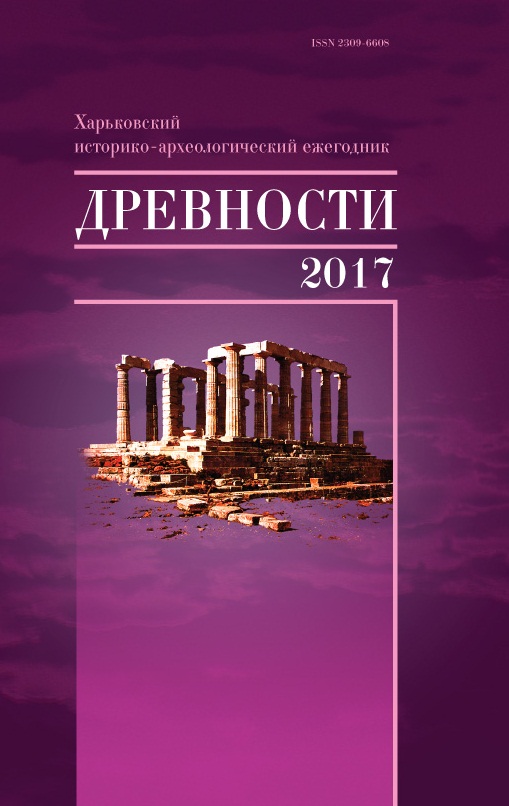Релігія як інструмент політики Помпея Великого
Анотація
Помпей демонстрував особливу прихильність до божеств перемоги. Його релігійна політика зазнала впливу релігійної політики Олександра Великого, Мітрідата Великого і Сулли. Помпей не сформулював власну чітку, до кінця продуману та прийнятну для більшості римлян релігійну концепцію. Його релігійність поєднувалася із забобонністю. Він не демонстрував особливої принциповості у питаннях релігії, віддавав перевагу вшануванню того чи того божества в залежності від політичної кон’юнктури. У Римі Помпей виказував особливу прихильність Венері, на грецькому Сході — Афіні. Його не бентежила підтримка Афіною ахейців у війні з троянцями, від яких вели своє походження римляни. Помпей використовував релігію для досягнення політичних цілей, не цурався почестей, які межують з божественними.
Завантаження
Посилання
Syme R. The Roman revolution. — Oxf.; N. Y., 1960.
Penrose J. Rome and her enemies: an empire created and destroyed by war. — Oxf.; N. Y., 2008.
Wylle G. The Road to Pharsalus // Latomus. — 1992. — Fasc. 3. — T. 51.
Santangelo F. Pompey and Religion // Hermes. — 2007. — Heft 2. — Bd. 135.
Muccigrosso J. Religion and politics: did the Romans scruple about the placement of their temples? // Religion in Republican Italy. — Cambridge, 2006.
Stewart R. The Jug and Lituus on Roman Republican Coin Types: Ritual Symbols and Political Power // Phoenix. — 1997. — No. 2. — Vol. 51.
Dillon M., Garland L. Ancient Rome: Social and Historical Documents from the Early Republic to the Death of Augustus. — L.; N. Y., 2015.
Koortbojian M. The Divinization of Caesar and Augustus: Precedents, Consequences, Implica- tions. — N. Y., 2013.
Weinstock S. Divus Julius. — Oxf., 1971.
Weinstock S. Victor and Invictus // The Harvard Theological Review. — 1957. — No. 3. — Vol. 50.
Kopij K. The Coins Related to Pompey the Great through the Lens of the theology of Victory // Proceedings of the 6th International Numismatic Congress in Croatia, University of Zadar, Zadar, Croatia, September 26–29, 2010. — Rijeka, 2011.
Orlin E. Urban Religion in the Middle and Late Republic // A companion to Roman religion. — Oxf., 2007.
Platner S. A Topographical Dictionary of Ancient Rome. — L., 1929.
Guest C. The understanding of ornament in the Italian Renaissance. — Boston, 2016.
Сморчков А. М. Религия и власть в Римской Республике: магистраты, жрецы, храмы. — М., 2012.
Scott K. The imperial cult under Flavians. — N. Y., 1975.
Молев Е. А. Властитель Понта. — Нижний Новгород, 1995.
Price S. R. F. Rituals and power: The Roman imperial cult in Asia Minor. — Cambridge, 1986.
Beard M., North J., Price S. Religions of Rome. — Cambridge, 1998.
Rüpke J. Die Religion der Römer. — München, 2001.
Hanson J. A. Roman theater-temples. — Princeton, 1959.
Richardson L. A New Topographical Dictionary of Ancient Rome. — Baltimore; L., 1992.
Hurlet F. The Roman Emperor and the Imperial Family // The Oxford handbook of Roman epig- raphy. — N. Y., 2015.
Kopij K. Opera Pompei and the Theology of Victory // Studies in Ancient Art and Civilization. — Krakow, 2010. — Pars 14.
Zanker P. The Power of Images in the Age of Augustus. — Ann Arbor, 1988.
Sear F. Roman theatres: an architectural study. — Oxf., 2006.
Lodge G. Caesar, Cicero, and Pompey // The Classical Weekly. — 1920. — No. 18. — Vol. 13.
Orlin E. Temples, religion, and politics in the Roman Republic. — Leiden; N. Y., 1997.
Gödde S. Theater // A companion to the archaeology of religion in the ancient world. — Hoboken, 2015.
Clark M. Walking through Rome: A Guide to Interesting Sites in the Eternal City. — Bloomington, 2013.
Benko S. The Virgin Goddess: Studies in the Pagan and Christian Roots of Mariology. — Leiden; N. Y., 1993.
Masi S., De Leonardis S. Rome and the Vatican: art and history. — Firenze, 2007.
Orlin E. Foreign cults in Rome: creating a Roman Empire. — Oxf.; N. Y., 2010.
Сапрыкин С. Понтийское царство: Государство греков и варваров в Причерноморье. — М., 1996.
Сапрыкин C. Религия и культы Понта эллинистического и римского времени. — М.; Тула, 2009.
Collins H. P. Decline and Fall of Pompey the Great // Greece & Rome. — 1953. — No. 66. — Vol. 22.




